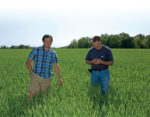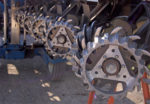Advertise Follow Us
Articles Tagged with ''No-till''
5 Steps To Boost No-Till Wheat Yields
Controlling weeds and head scab, and hiking seeding and nitrogen rates may help no-tillers find an edge with winter wheat.
Read More
New Specialty Crops Offer Bonus No-Till Income
Whether it’s soybeans, corn, sunflowers or canola, no-tillers can grow solutions to meet market demand for healthy and renewable oils, as well as more efficient ethanol production.
Read More
No-Till Brings New ‘Shade’ Of Higher Yields, Profitability
Johnny and Brian Moore’s switch to no-till, cover crops and a diverse rotation has stopped erosion, improved organic matter and made their North Carolina farm’s high-clay soils more productive.
Read More
A Cover Crop Bonus: Weed Suppression
With the pipeline of new herbicides hitting the market shrinking in the next decade, wisely chosen cover crops that establish quickly and are controlled properly can keep weeds at bay.
Read More
‘Heads Up’ Solutions For Managing Corn Residue
Chopping corn heads and new header technology are giving no-tillers much-improved tools to manage tough Bt corn residue in preparation for planting.
Read More
Manure, Crop Diversity Lock Down No-Till Profits
Koepke Farms tweaks its crop rotation, manure management and onfarm research to get the most from its no-till practices.
Read More
Row Cleaners: Coming Of Age
Engineering improvements and on-the-go adjustment are making it easier for no-tillers to clear residue from the row and improve seedling emergence, crop stands and yields.
Read More
What I've Learned from No-Tilling
Constantly Building On No-Till Success
South Dakota farmers Pat and Chris Breen take no-till practices that work a step farther to maximize the benefits.
Read More













